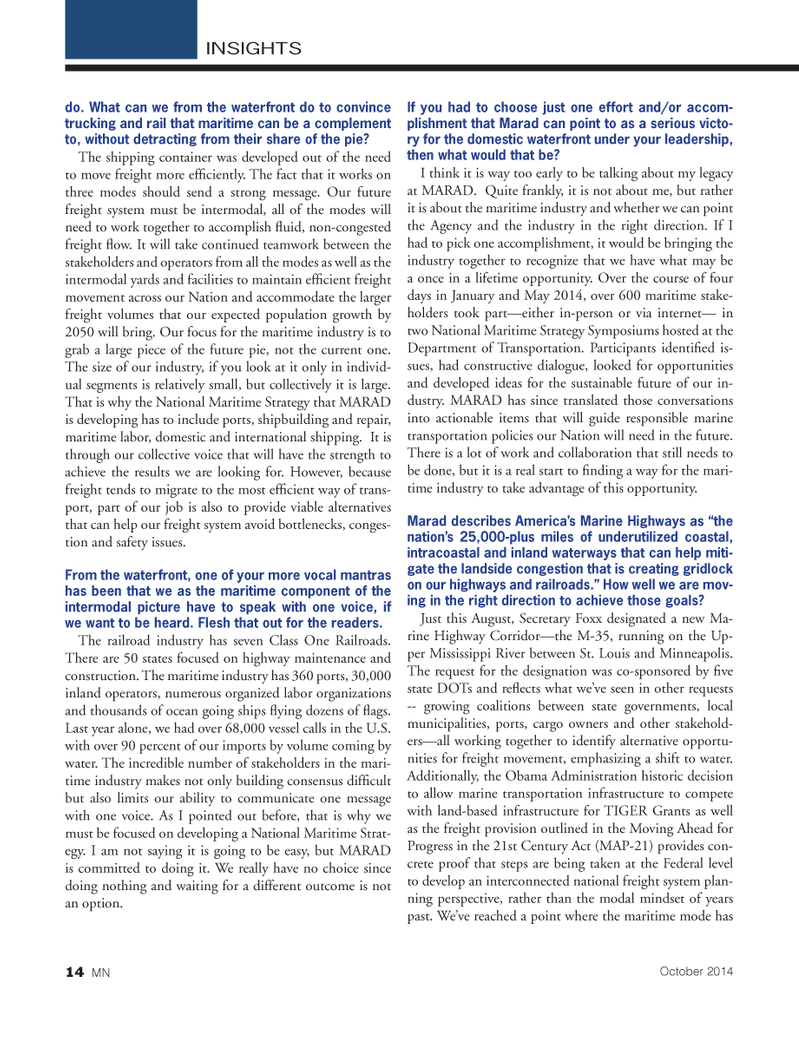
Page 14: of Marine News Magazine (October 2014)
Innovative Products & Boats - 2014
Read this page in Pdf, Flash or Html5 edition of October 2014 Marine News Magazine
INSIGHTS do. What can we from the waterfront do to convince trucking and rail that maritime can be a complement to, without detracting from their share of the pie?
The shipping container was developed out of the need to move freight more effi ciently. The fact that it works on three modes should send a strong message. Our future freight system must be intermodal, all of the modes will need to work together to accomplish fl uid, non-congested freight fl ow. It will take continued teamwork between the stakeholders and operators from all the modes as well as the intermodal yards and facilities to maintain effi cient freight movement across our Nation and accommodate the larger freight volumes that our expected population growth by 2050 will bring. Our focus for the maritime industry is to grab a large piece of the future pie, not the current one.
The size of our industry, if you look at it only in individ- ual segments is relatively small, but collectively it is large.
That is why the National Maritime Strategy that MARAD is developing has to include ports, shipbuilding and repair, maritime labor, domestic and international shipping. It is through our collective voice that will have the strength to achieve the results we are looking for. However, because freight tends to migrate to the most effi cient way of trans- port, part of our job is also to provide viable alternatives that can help our freight system avoid bottlenecks, conges- tion and safety issues.
From the waterfront, one of your more vocal mantras has been that we as the maritime component of the intermodal picture have to speak with one voice, if we want to be heard. Flesh that out for the readers.
The railroad industry has seven Class One Railroads.
There are 50 states focused on highway maintenance and construction. The maritime industry has 360 ports, 30,000 inland operators, numerous organized labor organizations and thousands of ocean going ships fl ying dozens of fl ags.
Last year alone, we had over 68,000 vessel calls in the U.S. with over 90 percent of our imports by volume coming by water. The incredible number of stakeholders in the mari- time industry makes not only building consensus diffi cult but also limits our ability to communicate one message with one voice. As I pointed out before, that is why we must be focused on developing a National Maritime Strat- egy. I am not saying it is going to be easy, but MARAD is committed to doing it. We really have no choice since doing nothing and waiting for a different outcome is not an option.
If you had to choose just one effort and/or accom- plishment that Marad can point to as a serious victo- ry for the domestic waterfront under your leadership, then what would that be?
I think it is way too early to be talking about my legacy at MARAD. Quite frankly, it is not about me, but rather it is about the maritime industry and whether we can point the Agency and the industry in the right direction. If I had to pick one accomplishment, it would be bringing the industry together to recognize that we have what may be a once in a lifetime opportunity. Over the course of four days in January and May 2014, over 600 maritime stake- holders took part—either in-person or via internet— in two National Maritime Strategy Symposiums hosted at the
Department of Transportation. Participants identifi ed is- sues, had constructive dialogue, looked for opportunities and developed ideas for the sustainable future of our in- dustry. MARAD has since translated those conversations into actionable items that will guide responsible marine transportation policies our Nation will need in the future.
There is a lot of work and collaboration that still needs to be done, but it is a real start to fi nding a way for the mari- time industry to take advantage of this opportunity.
Marad describes America’s Marine Highways as “the nation’s 25,000-plus miles of underutilized coastal, intracoastal and inland waterways that can help miti- gate the landside congestion that is creating gridlock on our highways and railroads.” How well we are mov- ing in the right direction to achieve those goals?
Just this August, Secretary Foxx designated a new Ma- rine Highway Corridor—the M-35, running on the Up- per Mississippi River between St. Louis and Minneapolis.
The request for the designation was co-sponsored by fi ve state DOTs and refl ects what we’ve seen in other requests -- growing coalitions between state governments, local municipalities, ports, cargo owners and other stakehold- ers—all working together to identify alternative opportu- nities for freight movement, emphasizing a shift to water.
Additionally, the Obama Administration historic decision to allow marine transportation infrastructure to compete with land-based infrastructure for TIGER Grants as well as the freight provision outlined in the Moving Ahead for
Progress in the 21st Century Act (MAP-21) provides con- crete proof that steps are being taken at the Federal level to develop an interconnected national freight system plan- ning perspective, rather than the modal mindset of years past. We’ve reached a point where the maritime mode has 14 MN
October 2014
MN Oct14 Layout 1-17.indd 14 9/19/2014 1:12:37 PM

 13
13

 15
15
